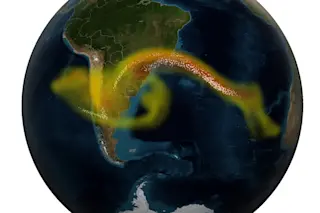Lava wasn’t called lava until Mount Vesuvius erupted in 1737. Francesco Serao used the word, derived from labes (“fall” or “slide” in Latin), to compare the hot ooze on the volcano’s slopes to mudslides after a heavy rain.
Lava is magma that has erupted above the planet’s surface. The most common variety of molten rock, either above ground or below, is basalt.
Basaltic lava the world over is classified with the Hawaiian words a’a or pahoehoe based on consistency. Pahoehoe tends to spread slowly — imagine cake batter poured into the center of a pan.
A’a lava, on the other hand, often advances erratically, including occasional sudden surges. The same eruption of lava can switch from pahoehoe to a’a, depending on factors such as thickness and how fast it’s cooling.
Be glad other types of lava aren’t as common. Both andesitic and rhyolitic magma have higher gas content and erupt much more explosively than basaltic.
The supervolcano beneath Yellowstone has rhyolitic magma, which tends to erupt catastrophically. Some good news: Geophysicists put the chance of it blowing in any given year at 1 in 700,000.
Some bad news: In 2015 researchers discovered Yellowstone has even more magma than we thought. Beneath the previously known magma chamber, there’s a second, larger reservoir with enough hot goo to fill the Grand Canyon 11.2 times.
Lava can be typed by chemical signature as well. Basaltic lava is mafic, an abbreviation of two of its prevalent elements, magnesium and ferrum, derived from the Latin word for iron.
Rhyolitic lava is felsic; the name is derived from feldspar and silica, which are present in high concentrations. Intermediate lavas, including andesitic, fall somewhere in between.
One kind of lava you really don’t want to deal with is corium lava. During a nuclear meltdown, uranium dioxide fuel, fuel rod components and even the reactor become superheated — as much as 3,600 degrees Fahrenheit — and melt together to form corium, which can eat through containment systems.
Although technically not lava, corium mimics its movement. The Elephant’s Foot, a highly radioactive corium glob that formed beneath the Chernobyl reactor during the 1986 disaster, looks remarkably like a cooled basaltic flow.
“Blue lava” is also not lava. The vivid electric-blue color of flows down the side of Indonesian volcano Kawah Ijen is actually caused by sulfuric gas released at the same time as plain-old basaltic lava.
The color of real lava is instructive, however. The lighter the color, the more fluid the lava: Bright orange indicates temperatures at 1,000 degrees Celsius and higher, while dark red is a comparatively cool 650 to 800 C.
Nearly black natrocarbonatite lava is an exception. It’s found in just one spot: Tanzania’s Oldoinyo Lengai volcano. The sodium-enriched lava is still fluid at just 540 C.
When completely cool, natrocarbonatite lava turns silvery, creating an otherworldly landscape around the volcano.
Our solar system’s largest volcano, Mars’ Olympus Mons, is composed of layers of ancient eruptions of basaltic lava. At about three times the height of Mount Everest, that’s a lot of lava.
Jupiter’s moon Io continues to spew massive fountains of hot lava. In August 2013, during a two-week period of intense activity, curtains of lava gushed from fissures hundreds of miles long.
Further afield, things get even hotter. Astronomers have identified at least four exoplanets, including Kepler-78b, likely covered in lava.
Earth was also awash with lava once, in our planet’s early days. In 2013 researchers suggested that these lava oceans were layered by density. Outer layers of lava and crystallized rock insulated deeper, superdense magma that remained hot for much longer than originally thought.
Did lava kill the dinosaurs? Maybe. About 65 million years ago, a massive basaltic lava flow covered much of India. The eruptions that created the flow released enough toxic gas to off T. rex and company, and may have been triggered by the asteroid that smacked into the other side of the planet at roughly the same time.

Newsletter
Sign up for our email newsletter for the latest science news
More on Discover
Stay Curious
SubscribeTo The Magazine
Save up to 40% off the cover price when you subscribe to Discover magazine.
Subscribe












